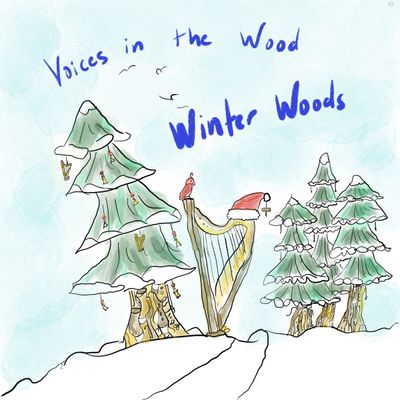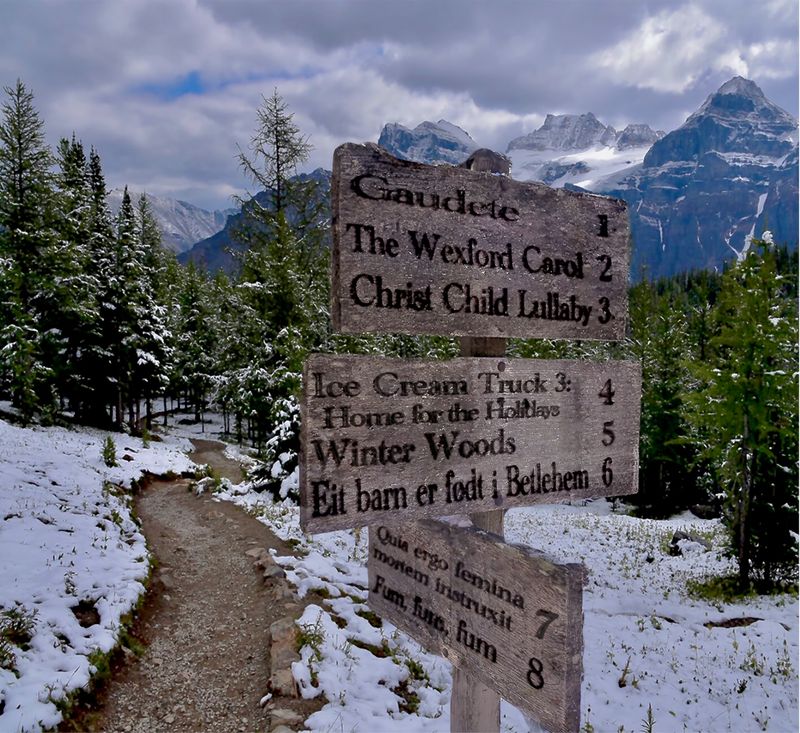Winter Woods

Album Tracks
Voices in the Wood is thrilled to announce the release of our new album, “Winter Woods”. Come along on a beautiful, wintry journey with us as the Voices ensemble brings to life music from our favorite winter and holiday traditions. Voices excels at high level musical artistry along with a true fluidity and joy that can only be brought to life by the sounds of bassoon and harp, Irish whistle, Scottish smallpipes, and other special guest instruments. From mystical, ancient melodies to tunes that are simply beautiful or delightfully humorous, Winter Woods will fill your home and heart with the spirit of the season.
Gaudete
Trad. 16th. c. Sweden/FinlandArr. Voices in the Wood- Sasha Enegren, Amber Ferenz, Kathleen Moniaci, Rosalind Buda, Staci Spring: bassoons & percussion
- Rosalind Buda: bombarde
- Staci Spring: contrabassoon
- Kelly Stewart: percussion
Rooted in the Latin word “Rejoice”, Gaudete kicks off this album with rowdy joy! The text of this popular sacred Christmas carol was published in Piae Cantiones, a 1562 collection of Finnish/Swedish sacred songs. While some suggest that the tune was written in the Early Modern era as well, it is also suspected to come from (or be influenced by) earlier sources. Our arrangement leans into the Medieval style by scoring the chant-like melody in parallel intervals and unisons. This is paired with lilting, dance-like rhythms based on the poetic meters of the text. Percussion, bombarde, and contrabassoon help to complete this raucous celebration!
The Wexford Carol
Trad. IrishArr. E. Hagenberg/K. Moniaci- Amber Ferenz, Sasha Enegren, Kathleen Moniaci, Rosalind Buda, Staci Spring: bassoons & percussion
- Rosalind Buda: Irish whistle
- Staci Spring: contrabassoon
- Kelly Stewart: harp
- Sean Brzozowski: mark tree
The Wexford Carol is a traditional Irish Carol that takes its name from the county where the song’s first transcriber resided. Dr. William Gratton Flood transcribed the words and music from a local singer in the early 20th century, resulting in the version we know today. Its true origins remain unknown, with debates on whether it was originally in English or Gaelic and if it was from the Medieval era or later. Our version is adapted from Elaine Hagenberg’s arrangement for choir, oboe, string quartet and percussion.
Christ Child Lullaby
Trad. ScotlandArr. R. Buda/K.Stewart- Amber Ferenz, Sasha Enegren, Rosalind Buda, Staci Spring, Kathleen Moniaci: bassoons
- Staci Spring: contrabassoon
- Kathleen Moniaci: jingle bells
- Kelly Stewart: harp
Christ Child Lullaby (Tàladh Chrìosda, in Scottish Gaelic) is an ancient melody that traces back to pre-Christian, pagan history and now has an important place in the Christmas music of the Outer Hebridies. The original song was sung as a blessing for protection for fisherman at sea, calling for their safe return. The gentle rise and fall of the melody mimics the rocking ocean waves, a perfect lullaby to soothe a sleeping child. The original, more ancient melody was used for the Christian “Christ Child’s Lullaby” and portions of the Chirstian lyrics can be traced back about 400 years. This hymn is still sung at midnight mass on the isle of Barra, Eriskay, and South Uist in the Outer Hebridies.
Ice Cream Truck 3: Home for the Holidays
Amber Ferenz- Sasha Enegren, Staci Spring, Rosalind Buda, Amber Ferenz, Kathleen Moniaci: bassoons
- Kelly Stewart: harp
It’s been a hot minute since the last time I rolled out the Ice Cream Truck, and for those of you who have been writing to ask me for a sequel, thanks bunches and this is for you! If you’re new to The Truck series, please know that this is the place for shenanigans. No, wait— Shenanigans, with a capital “S”.
Get yourself some holiday lights, crank up the contra, whip up enough egg nog for the whole bassoon studio, put on some festive sweaters, and find yourselves an adventurous harpist! All of us in Voices In the Wood hope you will enjoy playing this selection as much as we did while recording it. Happy Holidays!
Ice Cream Truck 3 is a medley of traditional Christmas carols fresh from the Holiday gig stack that remind me of my childhood. Here you’ll find Deck the Halls, Joy to the World, I Saw Three Ships, Coventry Carol, and Bring a Torch Jeannette Isabella. I arranged this medley especially for Voices In the Wood’s 2024 album release, Winter Woods, with Isabel “Gypsy” Richardson’s generous sponsorship. Thanks, Gypsy! - Amber Ferenz
Winter Woods
Amber Ferenz- Sasha Enegren, Staci Spring, Rosalind Buda, Amber Ferenz, Kathleen Moniaci: bassoons
- Kelly Stewart: harp
You have six Russian grandmothers who live in a secret cabin deep in the woods. Your grandmothers have asked you to come and visit them, and you’re on your way through the snowy forest. You know that when you get there, they will wrap you in soft warm blankets, feed you wonderful spiced cakes and many cups of tea, and sing you into the Dreaming after telling you many magical stories.
Winter Woods was originally written for bassoon quartet, and serves as the first movement of Tall Tales. I arranged this version for five bassoons and harp (or piano) especially for Voices In the Wood’s 2024 album release. - Amber Ferenz
Eit barn er født i Bethlehem
Trad. 16th c. DenmarkArr. Ø. Matre/VitW- Sasha Enegren, Kathleen Moniaci, Amber Ferenz, Rosalind Buda, Staci Spring: bassoons
- Rosalind Buda: Irish whistle
- Staci Spring: contrabassoon
- Kelly Stewart: harp
This beautiful arrangement finds its origins in the 13th century text and 14th century tune known as “Puer natus in Bethlehem” (A child is born in Bethlehem). Over the centuries, the text has been set in various languages and to different melodies across Germany and northern Europe. It was translated in the Danish psalmbook by N.F.S. Grundtvig, and in the Nynorsk Hymnal by Bernt Støylen in the early 20th century. Our adaptation was inspired by Ørjan Matre’s 2014 setting in Norwegian for chamber choir and instruments. We loved using our bassoon “voices” to bring this lush and inspiring melody to life.
Quie ergo femina mortem instruxit
Hildegard von BingenArr. A. Ferenz- Amber Ferenz: bassoon
- Rosalind Buda: soprano recorder
- Kelly Stewart: harp
These settings were commissioned by Isabel “Gypsy” Richardson especially for Voices In the Wood’s 2024 Winter Woods recording sessions. Thanks, Gypsy!
Setting the music of Hildegard von Bingen for modern instruments is no small thing. First, there’s the task of fitting meterless music into modern metered bars. Second, if I deviated too much from her original, absolutely stunning melodic structures, would the pieces even read as Hildegard’s music? I also felt that I couldn’t be too precious about historical accuracy since I was writing for the modern bassoon, recorder, and harp. I did my best to create chamber settings that stay true to the feel of her music, which I absolutely adore.
I have so much respect, gratitude and admiration for Hildegard’s life and work. Besides serving as a Benedictine nun and abbess, she was an astonishingly gifted polymath, composer (and lyricist!), visionary, mystic, philosopher, writer, and medical practitioner during the High Middle Ages, and left an enormous treasure trove of written works behind her. - Amber Ferenz
Fum, fum, fum
Trad. 16th c. CataloniaArr. Bussick/Voices in the Wood- Kathleen Moniaci, Rosalind Buda, Amber Ferenz: bassoons
- Staci Spring: contrabassoon
The translation of the title “Fum, fum, fum” is not quite clear. Smoke? Guitar strums? A rocking cradle? Ahem (clears throat) …”to do”?
The origins of this traditional Catalonian carol date back to the 16th century, with its lively rhythms echoing the Sardana dance of the Catalonian court. For a time it was part of the improvised tradition of the cançó de les mentides (“song of lies”) in the 18th/19th century, when Christmas was celebrated in debaucherous ways and satirical lyrics were made up to traditional tunes. Modern versions mostly feature texts related to the Christmas story, and it remains a popular addition to many Spanish Christmas carol collections. We decided to embrace the more absurd aspects of its checquered past by adding improvisatory contrabassoon and coconuts to David Bussick’s delightfully quirky arrangement
